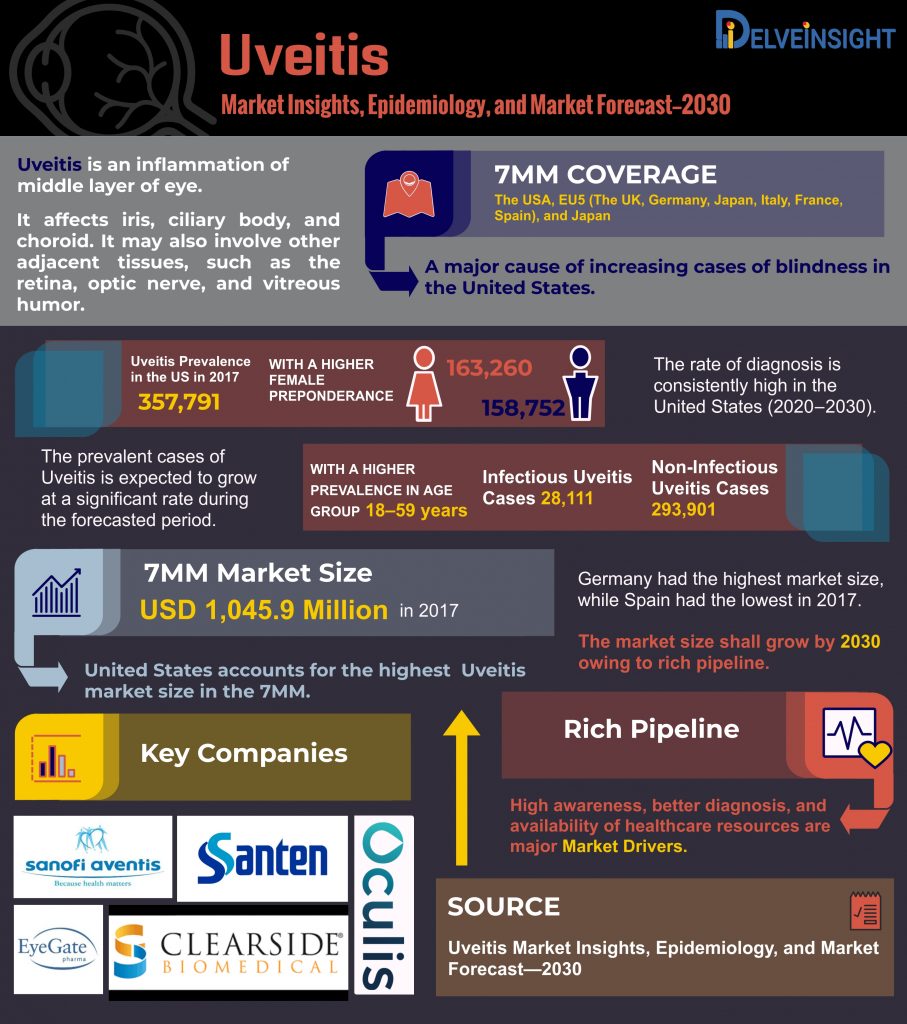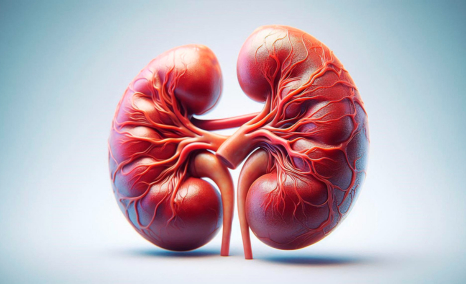One of the leading causes of blindness, and a sight-threatening disease, Uveitis, now has novel treatment approaches in its pipeline
May 29, 2020
Uveitis is an ocular inflammation of the uveal tract, the middle layer of the eyeball. The uveal layer is responsible for nourishing the eye, and if damaged, leads to progressive and irreversible damage. Uveitis generally starts from the damage in the uveal layer; however, the disease is not at all confined to the uveal tract. Besides, iris, ciliary muscles, and choroid, it affects other structures in the eye as well, including the retina, and retinal blood vessels.
Uveitis is the third leading cause of blindness worldwide, and a major one in the US with a total prevalence of 357,791 in 2017 in the US alone, estimated DelveInsight. Uveitis or the inflammation in the eye can be due to a pathogen such as bacteria or viruses. On that basis, the Uveitis is categorized as Infectious and Noninfectious. While the former case, it is Infectious Uveitis; the latter one happens due to responses mediated by the body’s T-cells and is due to an autoimmune response. In 2017, a total of 28,111 Infectious Uveitis cases, and 293,901 Non-infectious Uveitis cases were recorded in the United States.
Moreover, Uveitis is known to affect females more than males. This could be due to the fact that females have a heightened immune response to both foreign- as well self-antigens as compared to males, and since Noninfectious Uveitis is an autoimmune disease, and more prevalent, the apparent reason behind a greater female preponderance is quite clear. According to DelveInsight, there were a total of 163,260 females and 158,752 male cases of Uveitis in 2017 in the United States. Moreover, Uveitis can occur at any age. However, the most Uveitis prevalent cases were observed to be of age-group 18-59 years, whereas, the age group less than 18 years were least affected.
Downloads
Click Here To Get the Article in PDF
Recent Articles
- Cancer, diabetes and eczema on list; AbbVie’s Humira; Teva weighs $2B; Fresenius in buyout ...
- Future Avenues for Prediabetes Treatment: The Road Ahead
- Cardiovascular Disease: A major cause of health loss and a global burden
- Everything You Need to Know About Acute Kidney Injury
- ALCMI, ALCF and Scancell partner; Sun unloads Ohm Labs plants; Takeda and Ovid join; Guardant and...
Uveitis is almost always associated with a high risk of vision loss. According to a research by Miserocchi E, et al., 5% to 20% of the cases of legal blindness in the US and Europe, and 25% of the cases in developing nations are because of Uveitis. The trend presents a grim picture, and as per epidemiological studies, the prevalence will increase by 4 to 5 times if the current picture continues to prevail. It is necessary to understand the need for better and effective awareness of the disease. Since timely diagnosis and proper management of the disease are an indispensable aspect that can help avert the risk of permanent loss of the vision and hold equal importance as that of the treatment approaches available in the Uveitis Market.

Uveitis Market: Treatment approaches and Pipeline scenario
Several drugs are available for the management of the most prevalent noninfectious Uveitis, including corticosteroids, immunosuppressive agents, and, more recently, biologics. However, the current Uveitis therapeutic market is majorly dominated by Corticosteroids. In Uveitis, corticosteroids can be used topically, periocularly, intraocularly, or systemically. The Standardization of Uveitis Nomenclature Working Group Guidelines recommends the use of corticosteroids as first-line therapy for patients with active Uveitis. However, the administration of corticosteroids should always be short-term and started on a high dose to avoid resistance.
Moreover, the long-term use of corticosteroids is associated with extensive potential for severe systemic and ocular side effects, such as hypertension, diabetes, cataract, and glaucoma. In addition to corticosteroids, Multiple immunomodulatory therapy (IMT) drugs such as antimetabolites, calcineurin inhibitors, alkylating agents, and biologic agents are appropriate for uveitis therapy, but are still off-label. Other therapeutic options available in Uveitis Market but are still off-label include immunosuppressive agents such as Methotrexate, Azathioprine, Mycophenolate Mofetil, and Cyclosporine. Biologics are another option in the Uveitis Market used as the third line of therapy. Several biologics available are Etanercept, Infliximab, Toclizumab and Certolizumab that are off label; however, Humira (Adalimumab) is a first human monoclonal antibody being approved for the Uveitis.
However, the horizon appears bright with many therapeutic agents and approaches for uveitis and ocular inflammatory diseases in the pipeline. Different classes of agents, from calcineurin inhibitors to mTOR inhibitors and IL inhibitors, among others, are being evaluated. Moreover, delivery systems such as iontophoresis will also allow novel methods of safe and effective administration of pharmacologic agents.
Conclusively, the present Uveitis Market size shall grow for the forecast period owing to the launch of upcoming therapies in the 7MM from USD 1,045.9 million estimated in 2017, with the US anticipated to dominate most of the Uveitis Market share. Launch of emerging therapies, such as Sirolimus (for Non-Infectious Uveitis of the Posterior Segment (NIU-PS)), EGP-437 (for Non-Infectious Anterior Uveitis), Sarilumab (for Non-Infectious, Intermediate, Posterior or Pan-Uveitis (NIU)), Yutiq (EyePoint Pharmaceuticals: approved in the US), Iluvien (Alimera/EyePoint Pharmaceuticals: approved in EU) and Suprachoroidal CLS-TA ((Triamcinolone Acetonide): Clearside Biomedical)), and LME636 (Anterior Acute Uveitis), shall further create a positive impact on the market, and lead to better options for Uveitis patients.
Downloads
Article in PDF
Recent Articles
- NICE endorsement for Pfizer’s Vizimpro; Eisai, Dundee targets Cancer; Capital raise for AgaMatrix
- First oral GLP-1 treatment approved for type2 Diabetes
- What are the Top Five Leading Causes of Deaths in the World?
- Novartis’s Entresto; AZ, J&J and Lilly sharply cut death rates; CAR-T drugs worth; FDA warns
- CE Mark to Ibex’s Gastric Cancer Detection System; Senseonics’s Eversense E3 Continuous Glucose M...



